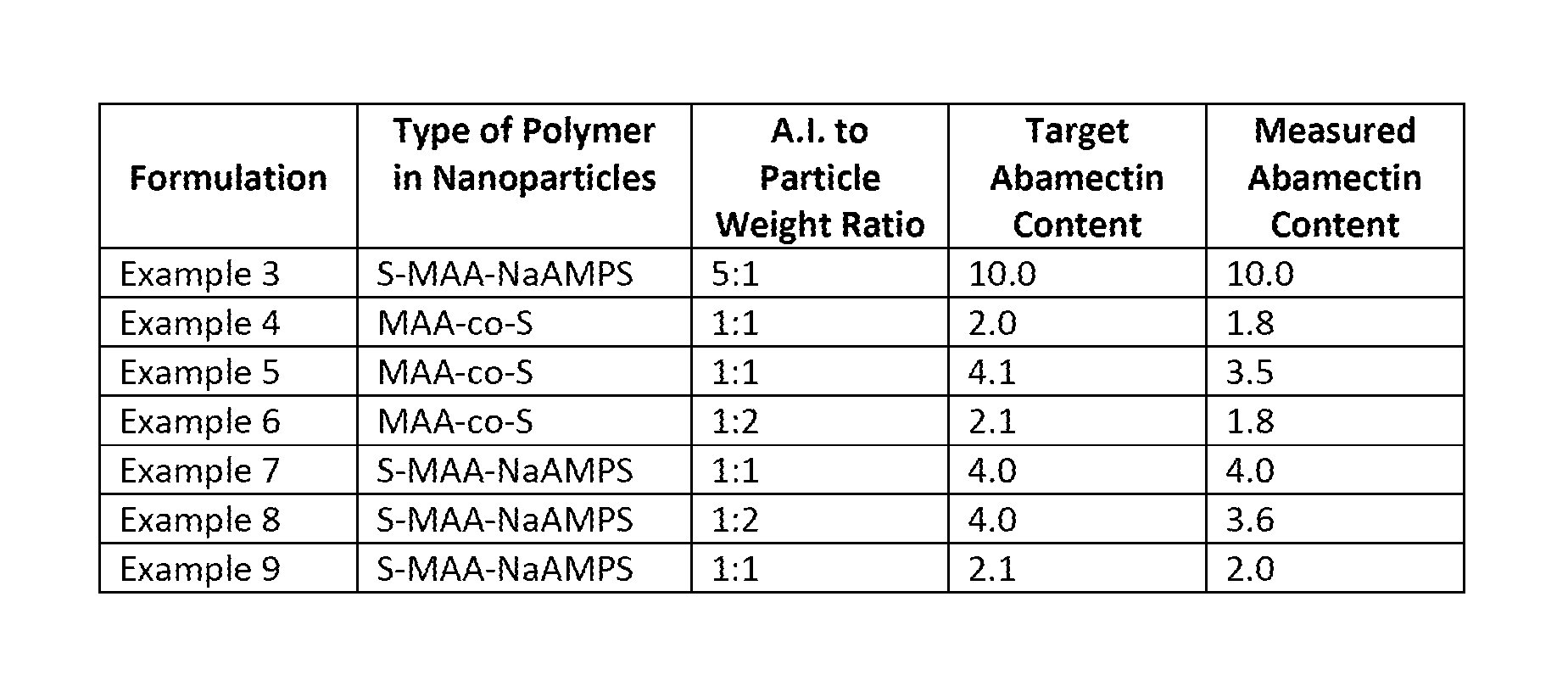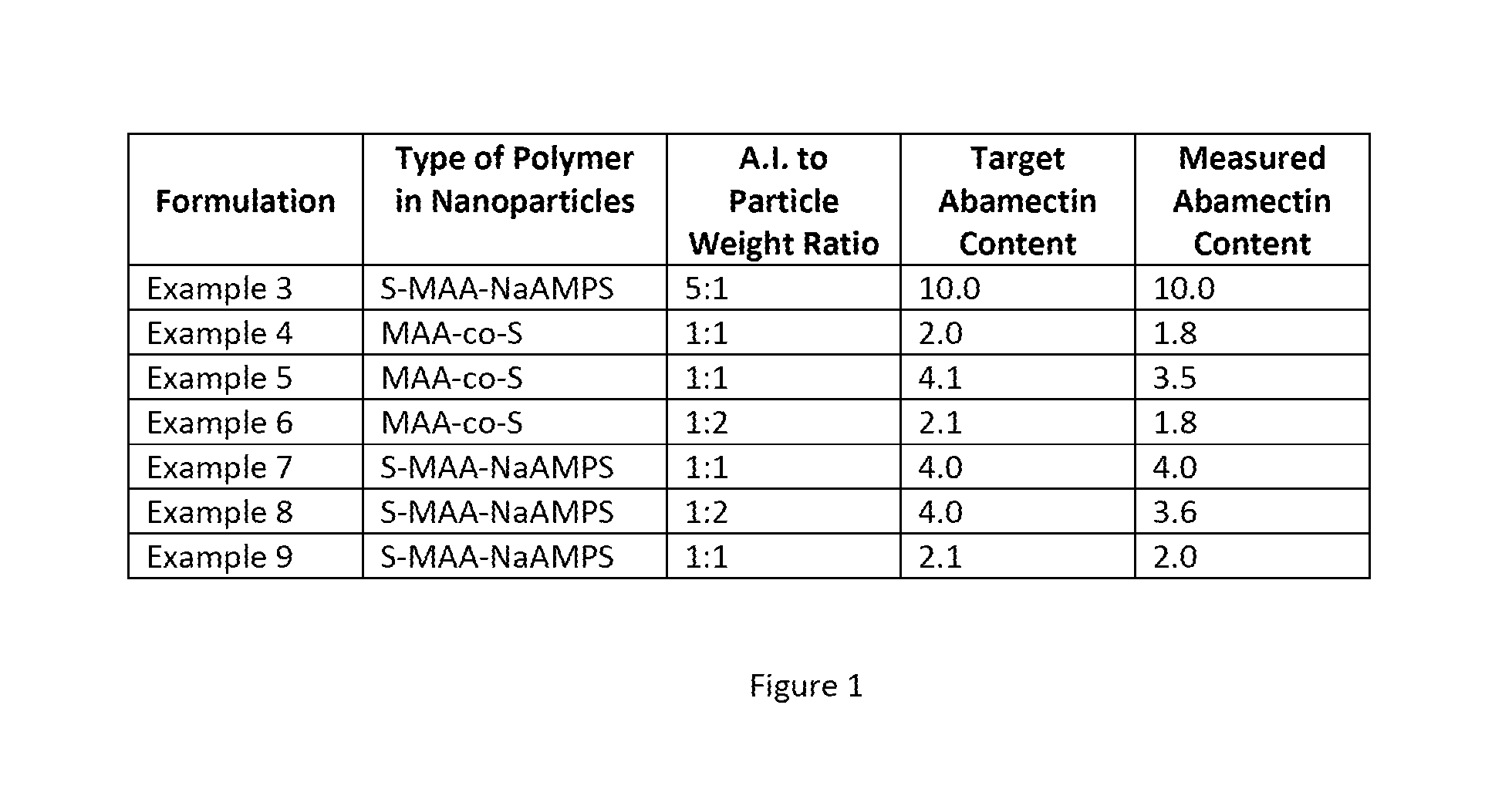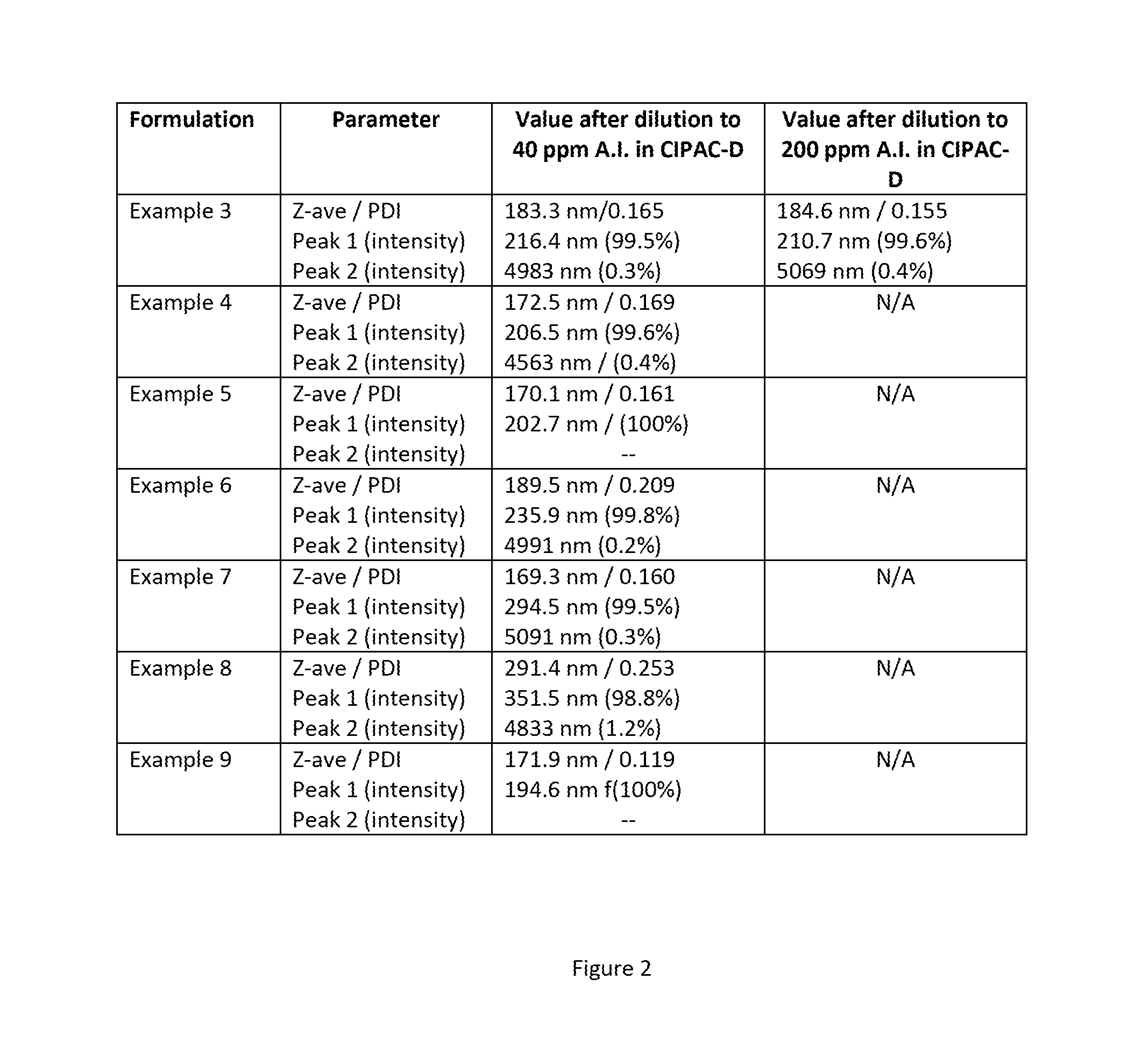Mectin and milbemycin polyelectrolyte nanoparticle formulations
a technology of polyelectrolyte and nanoparticles, which is applied in the field of mectin and milbemycin polyelectrolyte nanoparticle formulations, can solve the problems of low soil motility, rapid soil degradation by soil microorganisms, and photolysis
- Summary
- Abstract
- Description
- Claims
- Application Information
AI Technical Summary
Benefits of technology
Problems solved by technology
Method used
Image
Examples
example 1
Preparation of Polymer Nanoparticles from Poly(S-MAA-NaAMPS) [25-20-55 Weight Ratio of Input Monomers]
[0157]Into a 500 mL 3-neck round bottom flask (reactor) were weighed 110 g of Lubrizol 2403 (50 wt. % NaAMPS in water), 25 g of styrene, 20 g of MAA and 115 g of DMF (ACS reagent grade). The resulting solution was yellowish in color. The reactor was fitted with a mechanical stirrer, a condenser, and a rubber septum. 0.2 g of Vazo 88 [1,1′-azobis(cyclohexanecarbonitrile)] was dissolved in 10 mL of DMF (ACS reagent grade) in a 20 mL scintillation vial, which was then sealed with a rubber septum. A gentle flow of N2 was used to purge the contents of both the 500 mL flask and vial for 15 hours. The flask was then heated to 100° C. in a pre-heated oil bath for 10 min with mechanical stirring at 210 rpm. The Vazo 88 solution was transferred to the reactor via a double tipped needle. The resultant solution was yellowish. The reactor was maintained at 100° C. and continuously stirred at 250...
example 2
Preparation of Polymer Nanoparticles from Poly(S-MAA-NaAMPS), 30-10-60 Weight Ratio of Input Monomers
[0160]Into a two-necked 150 mL round bottom flask (reactor) equipped with a stir bar were weighed 12 g of solid NaAMPS and 90 g of DMF. Into a 20 mL glass scintillation vial were weighed 6 g of styrene and 2 g of MAA, which were then transferred to the flask. The flask was fitted with a condenser and a rubber septum. Into a separate 20 mL glass scintillation vial were weighed 0.2 g of Vazo 88 [1,1′-azobis(cyclohexanecarbonitrile)] and 10 g of DMF. A gentle flow of N2 was used to purge the contents of both the 150 mL flask and 20 mL vial for 6 hours.
[0161]The 150 mL flask was heated to 100° C. in an oil bath. The Vazo 88 solution was transferred to the flask via a double tipped needle. The flask was maintained at 100° C. and continuously stirred for approximately 20 hours.
[0162]The polymer was isolated via precipitation in isopropanol according to the following procedure: Into a 4 L g...
example 3
Preparation of a HSLS Formulation of Nanoparticles or Aggregates of Nanoparticles of Polymer-Associated Abamectin Via Ball-Milling [Nanoparticles Derived from p(S-MAA-NaAMPS); 5:1 Ratio of Abamectin:Nanoparticles]
[0164]A formulation targeting an active ingredient loading of 10.0% was prepared according to the following procedure: To a 20 mL glass scintillation vial were added 1.6324 g of Abamectin (technical grade), 3.0014 g of a 10 wt. % aqueous dispersion of p(S-MAA-NaAMPS) nanoparticles of Example 1, 0.1501 g of Geropon® T-77, 0.2994 g of Geropon® TA / 72, 0.1513 g of Atlox™ 4913, 0.7579 g of 1,2-propanediol, 0.6042 g of Trans 10-A, 0.0475 g of Proxel™ BD-20, 0.0148 g of 2-hydroxy-4-n-octyloxy benzophenone (UV-blocker) and 8.3852 g of RO water. 30 g of stainless steel shots (600-800 μm) were added to the vial, which was sealed, secured to a vortex and shaken on setting 6 for 3 days. The formulation was isolated from the steel shots via pipette.
[0165]When the formulation was dispers...
PUM
 Login to View More
Login to View More Abstract
Description
Claims
Application Information
 Login to View More
Login to View More - R&D
- Intellectual Property
- Life Sciences
- Materials
- Tech Scout
- Unparalleled Data Quality
- Higher Quality Content
- 60% Fewer Hallucinations
Browse by: Latest US Patents, China's latest patents, Technical Efficacy Thesaurus, Application Domain, Technology Topic, Popular Technical Reports.
© 2025 PatSnap. All rights reserved.Legal|Privacy policy|Modern Slavery Act Transparency Statement|Sitemap|About US| Contact US: help@patsnap.com



